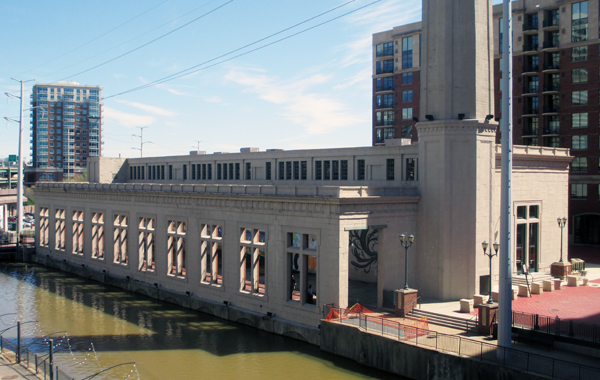
115-year-old Haxall Canal hydro plant (Photo by Burl Rolett.)
In the hustle of Richmond’s tax credit-fueled redevelopment rush in recent years, old urban buildings with at least some architectural character rarely stay on the market as long as the Haxall Canal hydro plant has.
But the 115-year-old building that once supplied power for Virginia Electric and Power Co. customers – and in a later life helped give a financial jolt for construction of the adjacent Riverside on the James condos – remains as dark as it was when it shut down about 50 years ago.
Local real estate professionals tend to agree that its location at 1201 Haxall Point and canal-fronting façade would make a great building for the right user. But while it’s an interesting-looking property, a list of complications, including its potential for tax incentives, makes the hydro plant a tough sell.
Last year, Cushman & Wakefield | Thalhimer broker Jeff Cooke took the 21,000-square-foot property out to market. The canal-side building drew several bites but no signatures.
“One was interested in doing a small hotel with some restaurant spaces, another was looking at it as a mixed-use, primarily entertainment-oriented building,” Cooke said of prospective buyers. “There’s a ton of ideas, but nobody I was talking to could really make the numbers work.”
Cooke’s listing expired earlier this year, and now the hydro plant’s owner, Baltimore-based Cordish Companies, is assessing its options.
“Right now we’re not looking to sell it necessarily. We’re looking to perhaps lease it,” Cordish Director of Development and Leasing John Knibb said. “We wouldn’t rule out selling it either if the right opportunity came along.”
The plant’s current state illustrates what can happen when there’s no obvious reuse for an old building in the tax incentive-charged market. And while it now sits vacant atop what could be prime real estate, its character and the lure of at least some incentives still may make it too much of a draw for developers to consider tearing it down and starting fresh.
Cordish has two plans it hopes could fill the building. Both avenues could include interior improvements, but neither comes without challenges.
The first idea is a destination-style nightclub and restaurant concept. Knibb said the building is far too large for one restaurant to take on, though, and that option would require at least two – and maybe more – tenants.
Jake Crocker, who headed the team that opened F.W. Sullivan’s next door to the hydro plant in October, said he’s seen hardly enough traffic to support the area’s dining scene as is. The canal also features Casa del Barco, a second concept from owner of the popular Boathouse restaurant, and the soon-to-arrive Mint Gastropub that is relocating from the Fan.
“None of us are doing spectacular by any way, shape or form,” Crocker said. “We’re hoping spring is better but it just doesn’t seem to be the destination place people are talking about.”
Cordish’s second plan would involve lofting the building to create multiple levels of office space, perhaps with one restaurant facing the drive-up roundabout between the Troutman Sanders building and the hydro plant.
Cordish knows a thing or two about that sort of concept. The firm is headquartered on the sixth floor of a former power plant on Baltimore’s Inner Harbor, and Knibb thinks the hydro plant would lend itself well to a similar conversion.
“We would be targeting the types of firms Richmond has a preponderance of,” Knibb said. “Marketing firms, ad agencies or an architecture firm.”
There’s plenty of room to divide the hydro plant into two stories, but Cordish might have to foot the bill for the project without the valuable historic tax credit incentive that so often fuels adaptive reuse in the city.
Tom Papa’s Foutainhead Development has done several historic tax credit jobs in the downtown area and is developing the Locks apartments on the other side of the canal in joint venture with WVS. He said the state’s Department of Historic Resources could shoot down a tax credit conversion that compromised the hydro plant’s elevated ceilings.
“Based upon all of the projects that we’ve done, I would say that there is a very good likelihood that you would not be able to build a whole lot of infill into the structure and have it qualify as a historic project,” Papa said.
Parking is another issue that will need to be addressed, whether the building becomes a restaurant row, office space or any other use that brings masses of people to the canal.
“You can’t put parking in the basement,” Papa said. “It’s surrounded by the canal on one side, the river is on two of the four sides and then it spills out into that cul-de-sac.”
Even if the hydro plant never changes hands or draws another tenant, its shell will still have done more than its share in powering development along the Haxall Canal.
When Cordish and Atlanta-based Daniel Corp. teamed up to develop the Riverside on the James condos and the Troutman Sanders building next door nearly a decade ago, the pair earned a Richmond municipal rehabilitation tax abatement on the condo building by virtue of connecting it to the hydro plant.
That means the owners are paying real estate taxes based on the value of the property that was there in 2005, not the 120 condominiums and $24 million worth of improvements Cordish and Daniel built at the site.
As a result, Riverside on the James is protected with a tax abatement of up to $23.85 million. At the current city tax rate of $1.20 per $1,000 in assessed value, that translates to $286,290 in potential tax savings each year. The abatement, which was issued a year before the city changed the abatement period from 15 years to 10, has another six years remaining.
The Troutman Sanders building next door earned a far more lucrative incentive, but that building did not use the hydro plant as its qualifying rehabilitation structure. Instead, the 15-story office building draws a $63 million tax abatement – the city’s largest real estate tax shelter of its kind – from a once-crumbling coal power plant it was built in place of.
Cordish and Daniel have since sold both the Troutman building and Riverside on the James to Herndon-based American Real Estate Partners. The tax abatements went to the buyer. Therefore, Cordish could lease, sell, improve, demolish or do whatever else it pleases with the hydro plant without affecting the condo building’s abatement.
The hydro plant property could also qualify for its own city tax abatement. Although the property is claimed as a qualifying structure for another building, the hydro plant itself is currently taxed at its full assessed value of $2.29 million.
As for the option to just demolish the plant and use its land for a new development, Knibb said that isn’t likely.
“I just don’t see that happening,” he said. “I would be very surprised if someone were to acquire it on a speculative basis. It’s going to be someone with a vision.”
Stakeholders on the canal have their own visions for best-case hydro plant scenarios.
Papa is interested in any use that could supplement the arrival of the Locks and its eventual 200 apartments in the neighborhood. He mentioned a distillery or brewery that could make use of the outdoor arcade area facing the canal.
Papa also floated the idea of a church where function could follow form by taking advantage of the plant’s cathedral-esque ceilings.
Crocker stressed the need for something that would appeal to local residents and not chase after tourist traffic he has yet to see at the canal.
“There’s no movie theater down there, and you have all those residents that are starting to fill in the Locks. You have more residential towers downtown,” he said. “As restaurant owners down there, it would be perfect for us – a ‘dinner and a movie’ kind of thing.”
Knibb thinks the building’s time for redevelopment may be drawing near.
“This area is taking on a coolness factor. I think this property’s time is maturing, and I would anticipate that something will happen in the short run,” Knibb said.

115-year-old Haxall Canal hydro plant (Photo by Burl Rolett.)
In the hustle of Richmond’s tax credit-fueled redevelopment rush in recent years, old urban buildings with at least some architectural character rarely stay on the market as long as the Haxall Canal hydro plant has.
But the 115-year-old building that once supplied power for Virginia Electric and Power Co. customers – and in a later life helped give a financial jolt for construction of the adjacent Riverside on the James condos – remains as dark as it was when it shut down about 50 years ago.
Local real estate professionals tend to agree that its location at 1201 Haxall Point and canal-fronting façade would make a great building for the right user. But while it’s an interesting-looking property, a list of complications, including its potential for tax incentives, makes the hydro plant a tough sell.
Last year, Cushman & Wakefield | Thalhimer broker Jeff Cooke took the 21,000-square-foot property out to market. The canal-side building drew several bites but no signatures.
“One was interested in doing a small hotel with some restaurant spaces, another was looking at it as a mixed-use, primarily entertainment-oriented building,” Cooke said of prospective buyers. “There’s a ton of ideas, but nobody I was talking to could really make the numbers work.”
Cooke’s listing expired earlier this year, and now the hydro plant’s owner, Baltimore-based Cordish Companies, is assessing its options.
“Right now we’re not looking to sell it necessarily. We’re looking to perhaps lease it,” Cordish Director of Development and Leasing John Knibb said. “We wouldn’t rule out selling it either if the right opportunity came along.”
The plant’s current state illustrates what can happen when there’s no obvious reuse for an old building in the tax incentive-charged market. And while it now sits vacant atop what could be prime real estate, its character and the lure of at least some incentives still may make it too much of a draw for developers to consider tearing it down and starting fresh.
Cordish has two plans it hopes could fill the building. Both avenues could include interior improvements, but neither comes without challenges.
The first idea is a destination-style nightclub and restaurant concept. Knibb said the building is far too large for one restaurant to take on, though, and that option would require at least two – and maybe more – tenants.
Jake Crocker, who headed the team that opened F.W. Sullivan’s next door to the hydro plant in October, said he’s seen hardly enough traffic to support the area’s dining scene as is. The canal also features Casa del Barco, a second concept from owner of the popular Boathouse restaurant, and the soon-to-arrive Mint Gastropub that is relocating from the Fan.
“None of us are doing spectacular by any way, shape or form,” Crocker said. “We’re hoping spring is better but it just doesn’t seem to be the destination place people are talking about.”
Cordish’s second plan would involve lofting the building to create multiple levels of office space, perhaps with one restaurant facing the drive-up roundabout between the Troutman Sanders building and the hydro plant.
Cordish knows a thing or two about that sort of concept. The firm is headquartered on the sixth floor of a former power plant on Baltimore’s Inner Harbor, and Knibb thinks the hydro plant would lend itself well to a similar conversion.
“We would be targeting the types of firms Richmond has a preponderance of,” Knibb said. “Marketing firms, ad agencies or an architecture firm.”
There’s plenty of room to divide the hydro plant into two stories, but Cordish might have to foot the bill for the project without the valuable historic tax credit incentive that so often fuels adaptive reuse in the city.
Tom Papa’s Foutainhead Development has done several historic tax credit jobs in the downtown area and is developing the Locks apartments on the other side of the canal in joint venture with WVS. He said the state’s Department of Historic Resources could shoot down a tax credit conversion that compromised the hydro plant’s elevated ceilings.
“Based upon all of the projects that we’ve done, I would say that there is a very good likelihood that you would not be able to build a whole lot of infill into the structure and have it qualify as a historic project,” Papa said.
Parking is another issue that will need to be addressed, whether the building becomes a restaurant row, office space or any other use that brings masses of people to the canal.
“You can’t put parking in the basement,” Papa said. “It’s surrounded by the canal on one side, the river is on two of the four sides and then it spills out into that cul-de-sac.”
Even if the hydro plant never changes hands or draws another tenant, its shell will still have done more than its share in powering development along the Haxall Canal.
When Cordish and Atlanta-based Daniel Corp. teamed up to develop the Riverside on the James condos and the Troutman Sanders building next door nearly a decade ago, the pair earned a Richmond municipal rehabilitation tax abatement on the condo building by virtue of connecting it to the hydro plant.
That means the owners are paying real estate taxes based on the value of the property that was there in 2005, not the 120 condominiums and $24 million worth of improvements Cordish and Daniel built at the site.
As a result, Riverside on the James is protected with a tax abatement of up to $23.85 million. At the current city tax rate of $1.20 per $1,000 in assessed value, that translates to $286,290 in potential tax savings each year. The abatement, which was issued a year before the city changed the abatement period from 15 years to 10, has another six years remaining.
The Troutman Sanders building next door earned a far more lucrative incentive, but that building did not use the hydro plant as its qualifying rehabilitation structure. Instead, the 15-story office building draws a $63 million tax abatement – the city’s largest real estate tax shelter of its kind – from a once-crumbling coal power plant it was built in place of.
Cordish and Daniel have since sold both the Troutman building and Riverside on the James to Herndon-based American Real Estate Partners. The tax abatements went to the buyer. Therefore, Cordish could lease, sell, improve, demolish or do whatever else it pleases with the hydro plant without affecting the condo building’s abatement.
The hydro plant property could also qualify for its own city tax abatement. Although the property is claimed as a qualifying structure for another building, the hydro plant itself is currently taxed at its full assessed value of $2.29 million.
As for the option to just demolish the plant and use its land for a new development, Knibb said that isn’t likely.
“I just don’t see that happening,” he said. “I would be very surprised if someone were to acquire it on a speculative basis. It’s going to be someone with a vision.”
Stakeholders on the canal have their own visions for best-case hydro plant scenarios.
Papa is interested in any use that could supplement the arrival of the Locks and its eventual 200 apartments in the neighborhood. He mentioned a distillery or brewery that could make use of the outdoor arcade area facing the canal.
Papa also floated the idea of a church where function could follow form by taking advantage of the plant’s cathedral-esque ceilings.
Crocker stressed the need for something that would appeal to local residents and not chase after tourist traffic he has yet to see at the canal.
“There’s no movie theater down there, and you have all those residents that are starting to fill in the Locks. You have more residential towers downtown,” he said. “As restaurant owners down there, it would be perfect for us – a ‘dinner and a movie’ kind of thing.”
Knibb thinks the building’s time for redevelopment may be drawing near.
“This area is taking on a coolness factor. I think this property’s time is maturing, and I would anticipate that something will happen in the short run,” Knibb said.



It should be noted that the Canal Cafe (adjacent to Sullivan’s) has closed up shop. Walked by there the other day for coffee and they were closed. The cleaning person told me it was permanent.
Personally I’d love to see a brewery or rooftop bar open in this space but don’t see it happening anytime soon.
This site lacks connectivity and visibility from the Canal Walk. The facade at the base of that building along with the tinted windows do not invite people from the Canal Walk like they need to. The giant railings dividing the Canal Walk from the plaza are also a barrier. I think the owners of the building would do well to install a water feature or public art in the courtyard area to draw people and make improvements to the base where Sullivan’s is to make any business there more visible and inviting. Removing the railings and adding steps would be… Read more »